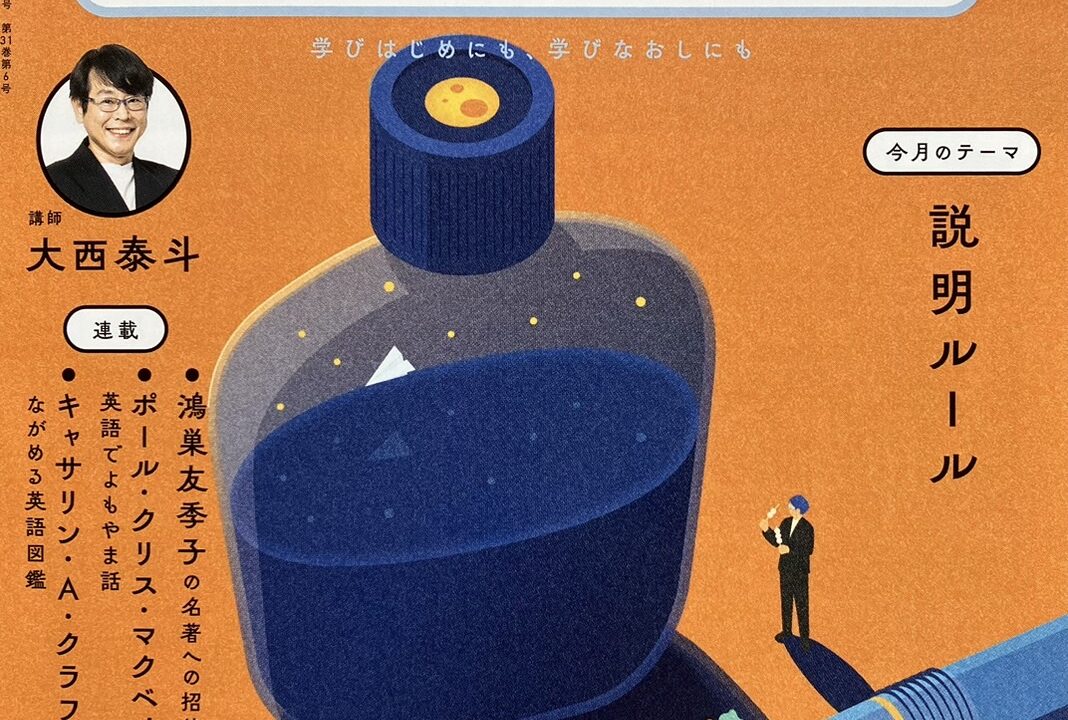【ラジオ英会話】Lesson 112 動詞句修飾⑥ – to不定詞で説明(感情の原因)- September 17 Tuesday, 2024

September 17 Tuesday, 2024
Lesson 112 動詞句修飾⑥ – to不定詞で説明(感情の原因)
☆Words & Phrases
**freshen up:
**shortly:
She needed to freshen up a bit. She’ll be back shortly.
How was your flight? – It was fine.
**my:
My, how you’ve grown, Roxy! You’re a lovely lady now.
Let’s get you home first.
Are you hungry? – Starving!
☆Grammar and Vocabulary
I’m so happy you’re here!
感情の原因を表す節
感情の原因を表すことができるのは、to不定詞だけではない。この文のように、感情を表す動詞句の後ろに「節」を置く形もたいへんポピュラー。
am so happy の原因説明が you’re here となっている。
Here comes your grandmother now.
現在形の「今まさに展開している状況」
現在形は時折「実演」など、目の前で出来事が展開している状況を表す。この文の Here comes ~ はその好例。
この形は誰か・何かが目の前にやってきていて、それが見えているときに使われる。

☆Target Forms
I’m excited to start my new year in university.
動詞(句)の後ろに to不定詞、「説明ルール: 説明は後ろに置く」によって、動詞(句)の説明となる。どういった説明になるかは文脈次第。
この文では am excited(興奮している)の説明ですから「どういった理由で?」という説明が最もピッタリです。
Practice
「感情の原因」を表す to不定詞は頻繁に使われます。まず「感情」、そしてその説明を後ろに並べる。この語順に慣れてくださいね。
am excited to
↓
am excited to start my new year in university
↓
I’m excited to start my new year in university.
① Pleased to meet you. I’m Olivia.
→ pleased(喜んで)の原因が to 以下。日常よく使われる表現
② She’s embarrassed to be late.
→ is embarrassed(恥ずかしい・バツが悪い)の原因が to be late
③ I’m frustrated to have to start over.
→ to の後ろに have to を置き、to不定詞として用いることもできる
★Practice
D: All right everyone. You know the routine. Today, we’ll use to「不定詞」to give extra information, and where does extra information go? That’s right, after the「動詞句」Here we go.
R: Repeat after us,
– Pleased
– Pleased to meet you
– Pleased to meet you. I’m Olivia.
D: Nice! All right. Let’s keep going,
– is embarrassed
– is embarrassed to be late
– She’s embarrassed to be late.
R: And one more,
– am frustrated
– am frustrated to have to start over.
– I’m frustrated to have to start over.
D: Unlock your potential.
R: Repetition is the key!
D&R: Great work.
☆Grammar in Action
①私は、ここであなたに会って驚いています。アートギャラリーをお好きだとは思っていませんでした。
**art gallery:
②ヴァネッサは、グアムに行くことにわくわくしています。彼女はこれまでアメリカ本土を離れたことはありません。
**the mainland US:
③ダニーは、君が無事だと知って喜ぶでしょう。彼に電話してニュースを伝えますね。
★Ending
O: Hey guys. Have you been to Guam?
D: Oh, I’ve been there once, just for a couple of days. I couldn’t do everything I wanted to, though.
R: I’ve never been. What about you, sensei?
O: I’ve been there. I wanted to go fishing and get a marlin.
**marlin tune:
September 17 Tuesday, 2024
Lesson 112 動詞句修飾⑥ – to不定詞で説明(感情の原因)
(日本語訳・解説付き)
☆Words & Phrases
**freshen up:(洗面所などで)化粧直しをする、さっぱりする
**shortly: 間もなく、すぐに
She needed to freshen up a bit. She’ll be back shortly.
ちょっと化粧室に行っているのさ。すぐに戻ってくるよ。
How was your flight? – It was fine.
空の旅はどうだったかな? – よかったわ。
※How was your flight? は、飛行機で来日した人に対して使えるフレーズですね!
※It was fine. の fine は「問題はない」なので「特に問題はなかった」です
**my:(驚きを表して)おや、まあ
My, how you’ve grown, Roxy! You’re a lovely lady now.
おやおや、ロキシー、すっかり大人になったね!もう、一人前のすてきな女性だ。
※you’ve grown と現在完了形になっているのは「育った今の状態」にフォーカスが当たっているからですね
Let’s get you home first.
ひとまず、お前と家に帰ろう。
※直訳すると「まずはあなたを家に帰そう」のようになります。get は「ある状態にする」ですね。なので「get someone somewhere」という形は、誰かをどこかにいる状態にする=連れて行く、または到着させる、となります。first は「まずは」ですね!
Are you hungry? – Starving!
お腹は空いているかい?- もうぺこぺこよ!
※starving は「お腹が空いた」を誇張的に表している表現です
☆Grammar and Vocabulary
I’m so happy you’re here!
あなたがここにいて、とてもうれしく思います!
感情の原因を表す節
感情の原因を表すことができるのは、to不定詞だけではない。この文のように、感情を表す動詞句の後ろに「節」を置く形もたいへんポピュラー。
am so happy の原因説明が you’re here となっている。
Here comes your grandmother now.
ほら、おばあさんがやってきました。
現在形の「今まさに展開している状況」
現在形は時折「実演」など、目の前で出来事が展開している状況を表す。この文の Here comes ~ はその好例。
この形は誰か・何かが目の前にやってきていて、それが見えているときに使われる。

☆Target Forms
I’m excited to start my new year in university.
私は、大学での新しい学年を始めることにわくわくしています。
動詞(句)の後ろに to不定詞、「説明ルール: 説明は後ろに置く」によって、動詞(句)の説明となる。どういった説明になるかは文脈次第。
この文では am excited(興奮している)の説明ですから「どういった理由で?」という説明が最もピッタリです。
Practice
「感情の原因」を表す to不定詞は頻繁に使われます。まず「感情」、そしてその説明を後ろに並べる。この語順に慣れてくださいね。
am excited to
↓
am excited to start my new year in university
↓
I’m excited to start my new year in university.
① Pleased to meet you. I’m Olivia.
お会いできてうれしく思います。オリビアと申します。
→ pleased(喜んで)の原因が to 以下。日常よく使われる表現
② She’s embarrassed to be late.
彼女は、遅刻したことを恥ずかしく思っています。
→ is embarrassed(恥ずかしい・バツが悪い)の原因が to be late
③ I’m frustrated to have to start over.
私は、最初からやり直さなければならなくて、フラストレーションがたまっています。
→ to の後ろに have to を置き、to不定詞として用いることもできる
★Practice
D: All right everyone. You know the routine. Today, we’ll use to「不定詞」to give extra information, and where does extra information go? That’s right, after the「動詞句」Here we go.
R: Repeat after us,
– Pleased
– Pleased to meet you
– Pleased to meet you. I’m Olivia.
D: Nice! All right. Let’s keep going,
– is embarrassed
– is embarrassed to be late
– She’s embarrassed to be late.
R: And one more,
– am frustrated
– am frustrated to have to start over.
– I’m frustrated to have to start over.
D: Unlock your potential.
R: Repetition is the key!
D&R: Great work.
☆Grammar in Action
①私は、ここであなたに会って驚いています。アートギャラリーをお好きだとは思っていませんでした。
I’m surprised to see you here. I didn’t think you liked art galleries.
**art gallery: アートギャラリー
②ヴァネッサは、グアムに行くことにわくわくしています。彼女はこれまでアメリカ本土を離れたことはありません。
Vanessa is excited to go to Guam. She’s never left the mainland US before.
**the mainland US: アメリカ本土
③ダニーは、君が無事だと知って喜ぶでしょう。彼に電話してニュースを伝えますね。
Danny will be happy to know you’re safe. I’ll call him and give him the news.
★Ending
O: Hey guys. Have you been to Guam?
D: Oh, I’ve been there once, just for a couple of days. I couldn’t do everything I wanted to, though.
R: I’ve never been. What about you, sensei?
O: I’ve been there. I wanted to go fishing and get a marlin.
**marlin tune: カジキマグロ
名古屋駅前にあるビジネス英語&仕事での英語雑談力をつけるための「名古屋BEGビジネス英会話ジム」
営業時間:平日 9:00~22:00 土曜日 9:00~19:00(日祝休み)
〒450-0002 愛知県名古屋市中村区名駅2丁目40-16 名駅野村ビル 5階



